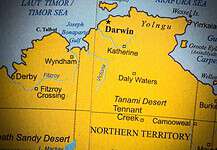Australia is in the midst of a greenfields discovery boom as investors plough their money into exploration projects across the country.
That was the general consensus at the ‘Explorers on the Move’ panel discussion featuring four well-respected mining company executives at the WA Mining Club recently.
But not all of them agreed on the extent of the labour shortage facing the resources sector.
Chalice Gold Mines managing director Alex Dorsch said Australia was experiencing a “new wave” of discoveries being driven partly by increasing demand for technology minerals.
“The last 10 years have been dominated by brownfields discoveries and what we are seeing just in the last year or so is some fantastic greenfields discoveries all around Australia,’’ he said.
“I can’t remember a time in Australia where we had so many major greenfields discoveries going on at once and it’s a hugely exciting thing.”
Chalice started 2020 as a $50m company with 15 employees.
Now the company has a market valuation of more than $800m with 30 full-time employees and another 30 contractors off the back of a high-grade nickel-copper-palladium discovery at its Julimar Project about 70km north east of Perth.
‘’It looks to be Australia’s first palladium discovery and to have made this rare type of discovery around the time of the COVID-19 pandemic and for it to be essentially under our noses just outside of Perth is nothing short of remarkable,’’ Mr Dorsch said.
‘’The company has been drilling on that discovery since March and we are enjoying success in the market and growing rapidly.
‘’We have essentially unlocked a totally new mineral province and it is a really game changing discovery by all accounts and we are aiming for a maiden resource in the middle of next year.’’
Mr Dorsch said demand for metals like nickel and copper was fuelling the new wave of exploration as the world moved to a low carbon future with an emphasis on sustainable technology like electric vehicles.
“It is exciting to hear people like Elon Musk at Tesla’s Battery Day talking about potentially getting into the nickel mining space, I think that is an early signal that nickel in particular, but a range of metals are going to be critically important to our lifestyles,” he said.
Legend Mining Managing Director Mark Wilson said investors were hungry to invest in exploration projects in Australia.
In his lifetime he could not recall another time when there had been the amount of “exciting, potentially company-making” discoveries as there had been in the last year.
Legend started as a silver explorer at the Elizabeth Hill project in the Pilbara before heading to West Africa for its Cameroon Project, which the company sold in 2014.
Now it is focused on its Rockford nickel project in WA’s Fraser Range where the company has exploration licenses covering 3000m2.
‘’Last year we have gone from a market capitalisation of $85m to $400m in that 12 months and the number of employees went from five to 20,” Mr Wilson said.
‘’My perspective on 2021 is I really hope the industry can deliver on the expectations that have been put on it with the choke point on the availability of labour to go about our business.’’
Mr Dorsch said the mining industry needed to do more to attract young talent.
‘’Getting drillers, fieldies and geologists in particular is a huge challenge and we really need to do better as an industry,’’ he said.
‘’We also need to invest heavily at the school level and make sure our tertiary education system is gearing up and equipping students with the tools in the right industries.’’
Trigg Mining founder and CEO Keren Paterson said they had a more positive experience recruiting as people have wanted to connect with the “purpose-driven” company’s role in achieving food security.
Ms Paterson said the industry had become too fixated on hiring people with mining related degrees and needed to think more broadly about the types of people who could contribute to their success.
She said Trigg is focused on securing Australia’s sustainable agriculture future through the exploration of essential potassium fertiliser, sulphate of potash (SOP), an important ingredient in global food production.
Trigg was on track to for a maiden air-core drilling program of up to 23 holes in the last week of September at its highly prospective Lake Throssell SOP project in Laverton, where the tenure has been expanded to 937sqm.
The program is designed to establish a maiden JORC Mineral Resources Estimate for Lake Throssel.
Novo Resources General Manager Exploration Kas De Luca said the demand for labour ebbed and flowed with the cyclical nature of the mining industry.
“We have some top-notch senior geologists who could all be exploration managers in their own right and they do a fantastic job of cascading their skill sets and knowledge-base down,” she said.
“That works really well, we are really not finding that much trouble in finding people to get interested in the conglomerate gold world.”
Ms De Luca said Novo was a well-funded exploration company in the process of becoming a producer with its Beatons Creek Gold Project in WA’s northern Pilbara region, where the company has a 14,000m2 landholding.
She said Novo was looking at enhancing the tonnage and the grade at the project.
“It’s a strategic area, we have 1200sq m of contiguous land holding there and 30 target areas we are wanting to assess and will be working on that soon.”
Ms De Luca said technology was playing a crucial role in exploration projects such as the work Novo is doing with mechanical ore sorting.
“I am astonished in a positive way in how we are taking old technologies in a sense and rebadging them.”
Mr Wilson said the key to undercover projects was not necessarily new technology but rather the “ability to integrate the cutting edge with chemistry, physics and good old-fashioned geology”.







































